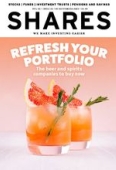Archived article
Please note that tax, investment, pension and ISA rules can change and the information and any views contained in this article may now be inaccurate.
How do global tracker funds like Fidelity Index World and iShares MSCI World differ?

Global equity tracker funds are popular among investors as they provide an easy and low-cost way to get exposure to stocks around the world. Choosing which tracker funds to put in your portfolio is not as straightforward as there are multiple products offering a similar approach. Read on to find out how they differ.
Five popular global trackers are Fidelity Index World (Acc:BJS8SJ3/Inc:BP8RYB6), iShares Core MSCI World ETF (IWDG), iShares MSCI ACWI ETF (SSAC), Vanguard FTSE Developed World ETF (VEVE) and Vanguard FTSE All-World ETF (VWRL). While they all provide diversified exposure to companies around the world, each fund has a subtle difference.
WHERE SHOULD I START?
You principally need to look at the index being tracked by each fund and the ongoing charges. None of the funds in this article are run by a manager, instead they track the performance of a basket of shares that meet certain criteria. The lack of a fund manager making active portfolio decisions means that ongoing charges are much lower than an active fund trying to beat the market.
Fidelity Index World has £5.4 billion of assets of management and a 0.12% ongoing charge. It tracks the performance of the MSCI World index, which contains approximately 1,500 large and medium-sized companies across 23 developed market countries.
The IWDG version of iShares Core MSCI World ETF follows the same index but is hedged to sterling and charges 0.3% a year.
Currency-hedged ETFs try to remove most of the currency risk that accompanies foreign investments. ‘Currency-hedged ETFs typically hold a basket of foreign stocks or bonds as their underlying investment along with currency-forward contracts that perform the hedging function,’ explains Morningstar. ‘These contracts effectively lock in a predetermined future exchange rate. In doing so, they eliminate the uncertainty of exchange-rate movements.’
There are additional versions of the iShares Core MSCI World ETF. The one using the code IDWR is priced in dollars whereas the IWRD version is in pounds.
ARE THERE LIMITATIONS TO THESE FUNDS?
While Fidelity Index World and iShares Core MSCI World ETF provide exposure to lots of companies around the world, it is important to note their focus on developed markets. Anyone who wants to broaden their horizons and also include emerging markets should look at funds that track the widely followed MSCI ACWI index.
ACWI stands for All Country World Index and contains a basket of nearly 3,000 stocks from across 23 developed market and 24 emerging market countries. iShares MSCI ACWI ETF tracks this index and charges 0.2% a year.
WHAT ABOUT VANGUARD FUNDS?
MSCI is not the only provider of indices used as the backbone of global equity tracker funds. FTSE, Amundi and Solactive are among the rival index providers, and Vanguard uses FTSE indices in many of its products.
Vanguard FTSE All-World ETF tracks the FTSE All-World index, which covers approximately 3,900 stocks in nearly 50 countries (both developed and emerging markets). As such, you will get broader coverage than iShares MSCI ACWI but the ongoing charge is slightly higher at 0.22%.
In contrast, Vanguard FTSE Developed World ETF chops out the emerging markets coverage you would get with Vanguard FTSE All-World and just focuses on the developed markets. It has exposure to just over 2,000 stocks and has a 0.14% ongoing charge.
WHICH COMPANIES WOULD I GET EXPOSURE TO?
Developed market companies dominate the top holdings of all the tracker funds discussed in this article. You’ll get exposure to names such as Apple (AAPL:NASDAQ), Microsoft (MSFT:NASDAQ), Amazon (AMZN:NASDAQ), Nvidia (NVDA:NASDAQ), Alphabet (GOOGL:NASDAQ) and Tesla (TSLA:NASDAQ), among many others.
Just remember that if you opt for one of the developed market tracker funds in this article over one that covers developed and emerging markets, you will get a large weighting to the US, as that is where many of the biggest companies are found. It’s worth bearing this in mind if you are trying to build a balanced portfolio and already have a US fund.
IS DEVELOPED MARKET EXPOSURE ENOUGH OR DO I NEED EMERGING MARKETS AS WELL?
If you want exposure to global markets through a single tracker fund, you need to decide whether to go for developed markets or both developed and emerging markets. A tracker fund should in theory deliver the same return as its underlying index minus fees.
To compare past performance, we looked at four key indices priced in sterling over a short and extended period. Over 10 years, the two developed market indices outperformed the ones which also included emerging markets.
The MSCI World index returned 196% and the FTSE Developed index returned 193%, whereas FTSE All-World returned 179% and you would have got 177% from the MSCI All-Country World index.
This outperformance trend was the same on a one, three and five-year basis, although the gap was narrow over the past year.
That’s not to say the developed indices will always outperform. Emerging markets are volatile – when they’re going through a bad patch, performance can disappoint, but historically they have delivered periods of strong returns when times are good.
DISCLAIMER: Daniel Coatsworth who edited this article has a personal investment in Fidelity Index World.
Important information:
These articles are provided by Shares magazine which is published by AJ Bell Media, a part of AJ Bell. Shares is not written by AJ Bell.
Shares is provided for your general information and use and is not a personal recommendation to invest. It is not intended to be relied upon by you in making or not making any investment decisions. The investments referred to in these articles will not be suitable for all investors. If in doubt please seek appropriate independent financial advice.
Investors acting on the information in these articles do so at their own risk and AJ Bell Media and its staff do not accept liability for losses suffered by investors as a result of their investment decisions.
Issue contents
Feature
Great Ideas
News
- Analyst forecasts big increase in profits at Entain and Flutter Entertainment
- Novo Nordisk shares continue to soar on strong demand for its weight-loss drugs
- Risk appetite returns after softer US jobs data signals rate pause
- Experts rate shares in housebuilders as good value despite property price shock
- Walgreens’ shares droop as CEO Brewer steps down

 magazine
magazine








